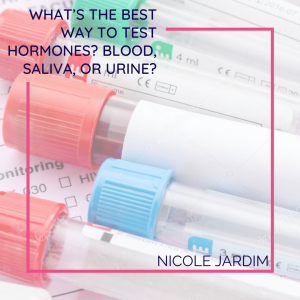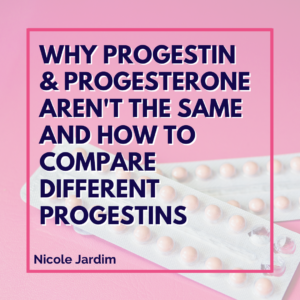I get asked about hormone testing and the best way to do it about 5 times a day on social media, on the blog and via email. Even my friends reach out about it.
This tells me that YOU want to take charge of your healing and become an active participant in your health care. Right on!
So, what is the best way to test hormones?
Believe it or not all of them can be useful, but for different reasons, which I explain below.
Here’s a mini breakdown on three popular types of testing…
1. Blood testing
These tests are also known as serum hormone tests, and they are the ones most commonly performed by your doctor. Blood tests are well-accepted with long-established reference ranges, they’re reliable and easy for you (that is, if you don’t mind needles).
Good news is now is you can do blood tests at home with just a finger prick through a company I’ve partnered with called Let’s Get Checked. And more good news, you can also now get 20% off all their tests using discount code HORMONES20! You’ll receive your test kit in the mail, and once you do the test you ship it back and a nurse practitioner will call you with your results in about 5-7 business days.
Serum (blood) tests are best for testing the thyroid (make sure to ask for the full thyroid panel that includes TSH, free T3 and free T4, and antibodies TPO and TGAB), LH, FSH, prolactin, fasting insulin, and sex hormone binding globulin (SHBG).
While blood tests give you a pretty accurate picture of what’s happening with your hormones, these tests can’t differentiate between free and bound hormone levels, which is important because free hormones tell you how much is available to be used by the body.
One way to make up for this is testing your SHBG (sex hormone binding globulin) because it’s one of those hormones that binds up your sex hormones estradiol and testosterone. If SHBG were high, it might mean that less estradiol and testosterone are available in your body. However, this is not necessary if you are just wanting a baseline picture of what’s up with your hormones.
Basically, blood tests are like a single snapshot of a person’s hormones, taken once, because it’s not really feasible to do multiple blood collections, like you would if you were collecting saliva and urine (however, those have their own limitations too). This single snapshot is a limitation because hormones are pulsed out at different times of the day and night, so the test you take might not accurately represent the actual level of the hormone but rather a peak value when it’s just released or a lower value when there is a lull in its release.
Ultimately, blood testing will give you a decent picture of what is going on with your hormones so I consider it to be a good bet. There are more accurate and in-depth tests like dried urine, but blood is a good place to start, especially when trying to determine your hormonal baseline.
As I mentioned above, I’ve partnered with Let’s Get Checked and you can get 20% off your order with the code Hormones20. Scroll down to see the testing options for different period-related issues.
2. Saliva testing
Saliva tests are a bit more comprehensive, and they’re available without a doctor’s visit or prescription. You can purchase saliva-based tests through a number of websites like EverlyWell and ZRT Labs, do the test at home and mail the test kit in to the lab. They will then email the results to you.
Unlike serum tests, saliva tests show the bioavailable hormones or the free hormones versus the total amount in the bloodstream. They also allow for multiple collections, which, as I mentioned, provides a more accurate big picture. It’s a great option for diurnal cortisol, which means you’re collecting samples four times a day to see what your cortisol does from morning to evening.
However, there are limitations with saliva testing.
- It can only be done for the steroid hormones, such as cortisol and the sex hormones. For instance, it won’t work for thyroid testing.
- Very specific guidelines must be followed in order to collect an accurate sample. There are restrictions around eating, drinking, lipstick, chewing gum, and teeth brushing that must be observed to get a usable specimen. This is because bleeding gums can contaminate the saliva sample.
- These tests are very much affected by topical and oral hormone usage, which appears to disproportionately raise saliva levels. If you are on prescribed hormone supplements you should consider urine testing.
Saliva is a good option for cortisol and the steroid sex hormones like estrogen, progesterone and testosterone.
3. Dried Urine testing
The Dried Urine Test for Comprehensive Hormones or DUTCH is a newer player in the testing market. It allows for individual collection of urine samples without the inconvenience of multiple jars (traditional urine testing). Instead, you’re just soaking a pad in urine and allowing it to dry, according to the instructions provided in the kit.
The DUTCH test collects a very large amount of data, including the basics of the sex and adrenal hormones, as well as for all of the hormone metabolites. The metabolites are where it’s at, meaning that you’re able to get a clearer picture of how your body is breaking down (or metabolizing) your hormones. Hormone metabolites for estrogens, progesterones androgens, and cortisol.
DUTCH offers a test called the Cortisol Awakening Response (CAR) which is an improvement over the regular saliva testing for cortisol because you can see what your cortisol is doing first thing upon awakening. This very helpful because you’re able to see if you have an exaggerated or a blunted cortisol response on waking, which are connected to depression, chronic fatigue, joint pain, poor sleep, postpartum depression and more.
The comprehensive nature of the test is a major advantage of the DUTCH test. It combines the advantages of serum, saliva, and urinary testing, all in one. Plus, it’s a very easy test to take!
However, thyroid hormones can’t be measured in urine so these must be done in blood testing. The DUTCH is expensive and the results report is complicated, which is why it is necessary to have a trained practitioner to review and interpret the results. If you can afford the test and you’ve got a practitioner who is trained to understand the DUTCH test then I recommend you get this test. If that’s not in the cards for you right now, then keep reading!
There you have it – a breakdown of three popular types of hormone testing. But which test should you do?
While I am a huge fan of the DUTCH test, I recognize that it’s not accessible to many people because of the cost and the fact that the results have to be reviewed and interpreted by a trained practitioner.
So I’d suggest some of the tests below from Let’s Get Checked, a company I’ve partnered with to bring you at-home testing that’s easy and reliable. What’s even better is that a nurse practitioner calls you with your test results and will review them with you.
Keep in mind that for any test you do, you’ll want to make sure you’re comparing your results to the functional reference ranges I’ve provided below. These slightly differ from standard reference ranges because rather than being based on results from people who are already sick, the functional ranges are based on what your ideal numbers should be when not sick! See below each test for the functional reference ranges.
Which hormone tests should you get?
PMS/PMDD, Painful and Heavy Periods
If you have PMS or PMDD, spotting 3-10 days before your period, a short luteal phase, short menstrual cycles, long or heavy periods then I suggest starting with the Female Hormone Test and the Progesterone Test.
I think a thyroid test is very important in this scenario because of how closely connected the thyroid is to our menstrual cycles. If you have long, heavy periods, period pain, along with low energy or fatigue, hair loss, dry skin or hair, then definitely check out the Thyroid Antibody Test in addition to the Female Hormone Test and the Progesterone Test.
Missing or Irregular Periods
If you have long cycles or your period is irregular (it comes every 35 days or more and/or you don’t know when it will arrive), then I suggest starting with the Female Hormone Test and the Progesterone Test.
I think a thyroid test is also helpful in cases like this to see if your thyroid is playing a role in your cycle woes. As above, you’d want to do the Thyroid Antibody Test in addition to the Female Hormone Test and the Progesterone Test.
Don’t forget the progesterone test needs to be done 5-7 days after ovulation so make sure to be paying attention to ovulation signs. If you don’t yet know how to do that, then read this post on charting your cycle.
Vitamin Testing for everyone
I am also a big fan of the Vitamin B12, Folate and Vitamin D tests for all of us. All three of these vitamins play a crucial role in the health of our menstrual cycles and fertility, and we should know these levels.
Functional ranges:
- Vitamin B12 – 450-2000
- Folate – higher than 8.0
- Vitamin D – 35-60
Remember: use discount code HORMONES20 to get 20% off all tests at Lets Get Checked!
Female Hormone Test
At home female hormone test to provide a broad picture of a woman’s hormonal health, with online results in 5 days.
Biomarkers covered:
- Follicle Stimulating Hormone (FSH)
- Luteinizing Hormone (LH)
- Prolactin
- Oestradiol
Progesterone Test
At home Progesterone test to confirm if ovulation has occurred about 5-7 days after ovulation. It’s important to know when you are ovulating so you can get an accurate progesterone measurement. I do not recommend day 21 of the cycle because most of us do not ovulate on day 14 of our cycles.
Biomarkers covered:
- Progesterone Hormone
If you have long, heavy periods, period pain, along with low energy or fatigue, hair loss, dry skin or hair, then definitely check out the Thyroid Antibody Test in addition to the Female Hormone Test and the Progesterone Test.
Thyroid Plus
This at home thyroid antibody test will provide a complete picture of how your thyroid is performing, with online results in 2 to 5 days.
Biomarkers covered:
- Thyroid Stimulating Hormone (TSH)
- Free Thyroxine (FT4)
- Free Triiodothyronine (FT3)
- Thyroglobulin Antibodies (TGAB)
- Thyroid Peroxidase Antibodies (TPO/TPEX)
Functional ranges:
- TSH – 0.5-2.0
- Free T4 – 1.0-1.5
- Free T3 – 2.5-4.0
- TPO – 0-34
- TGAB – 0-0.9
- Reverse T3 – 9-21
Have questions? Comment below or email support@nicolejardim.com.
Happy testing!



